Report: Key Leadership and Management Theories in Business Context
VerifiedAdded on 2023/01/05
|9
|2679
|29
Report
AI Summary
This report provides a comprehensive analysis of leadership and management theories, using the H&M clothing company as a case study. It explores key concepts such as transformational leadership, situational theory, and various leadership styles including autocratic, democratic, and laissez-faire. The report delves into motivational and team working principles, including Belbin typology, administrative management theory, and Vroom's expectancy theory. Furthermore, it examines the extent to which effective management and leadership contribute to organizational effectiveness, considering the impact of leadership and management behaviors on the company's mission and vision. The report also addresses how managers and leaders can facilitate change using tools like Lewin's change model, ultimately aiming to provide insights into improving organizational performance and adapting to changing environments. The report emphasizes the importance of effective communication, mutual respect, and the application of various theories to improve organizational outcomes and facilitate change management.
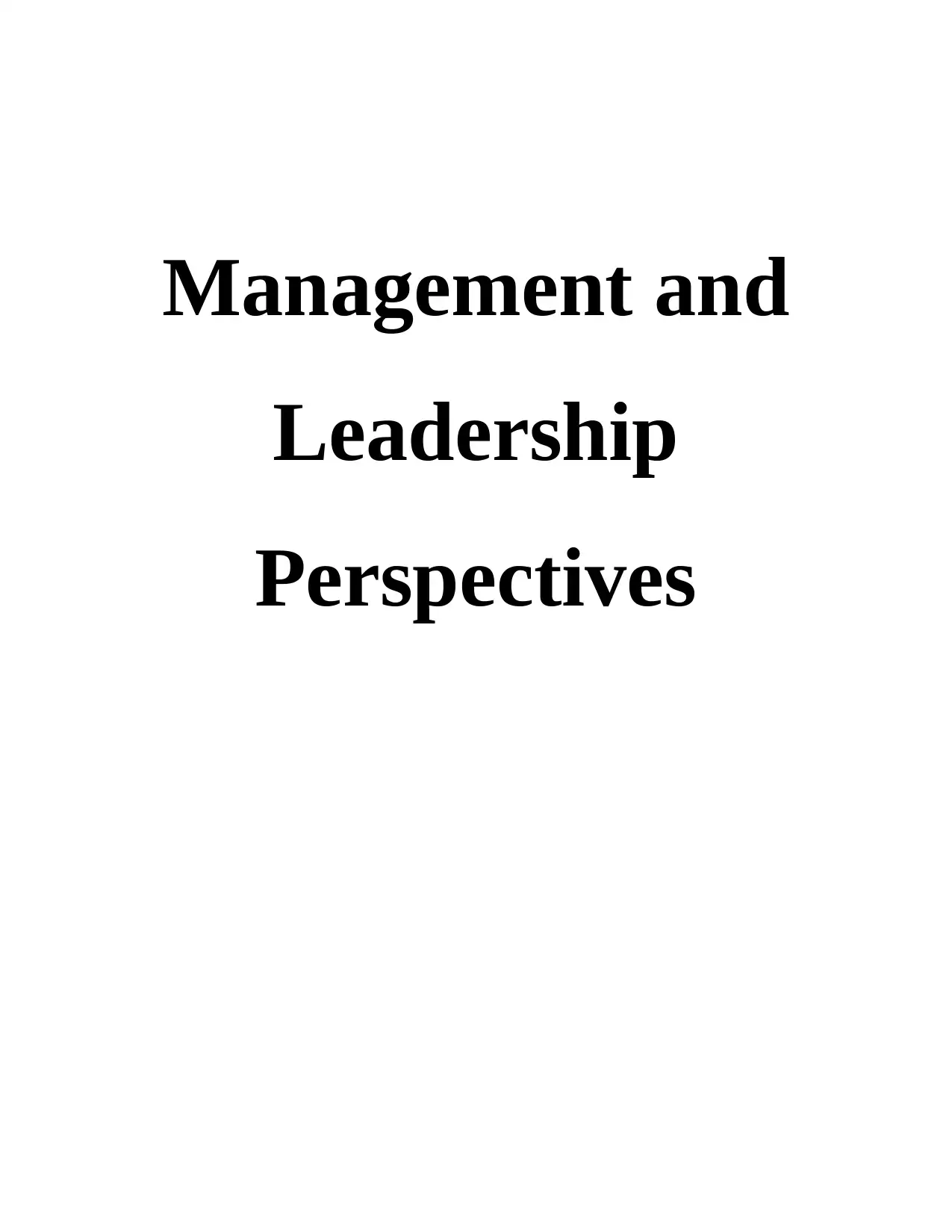
Management and
Leadership
Perspectives
Leadership
Perspectives
Paraphrase This Document
Need a fresh take? Get an instant paraphrase of this document with our AI Paraphraser
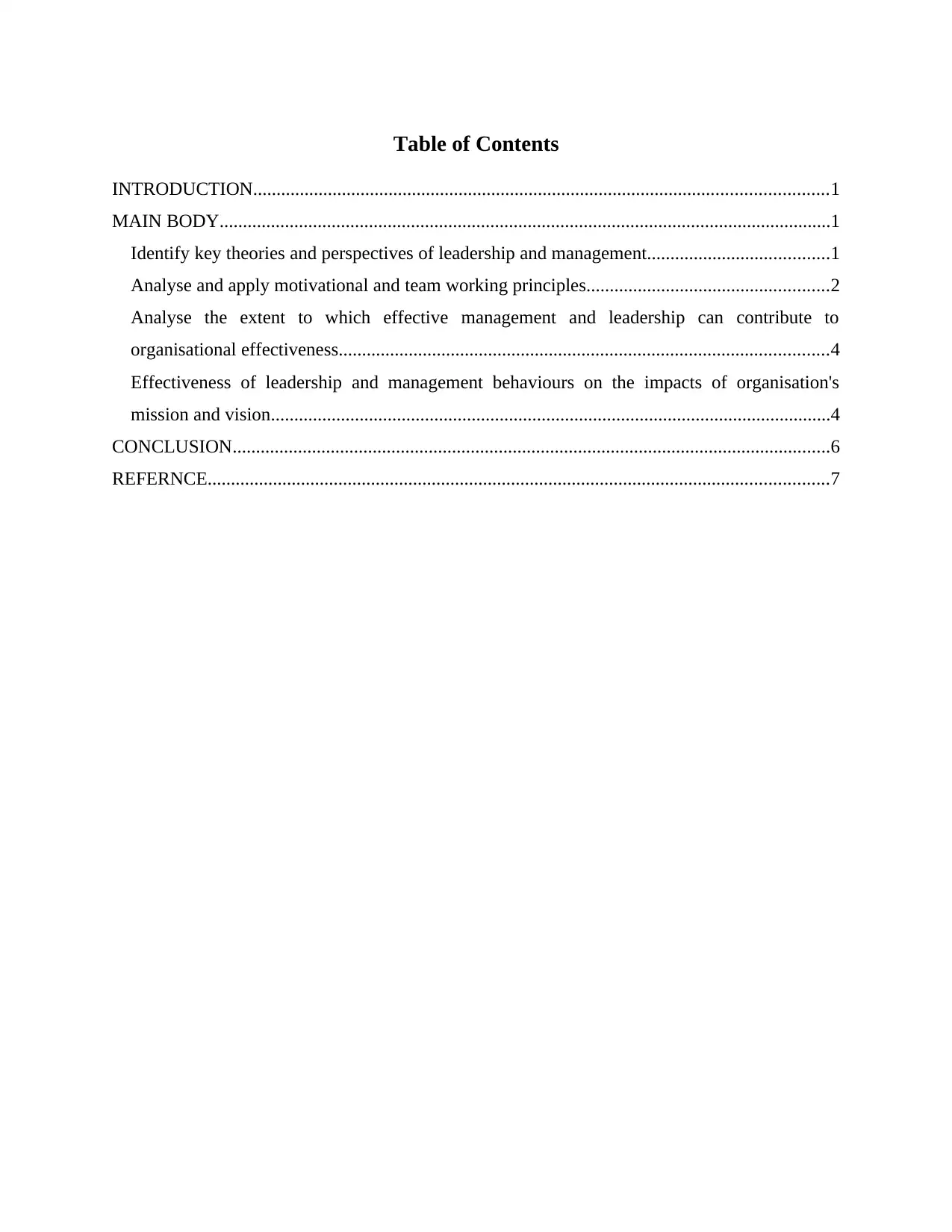
Table of Contents
INTRODUCTION...........................................................................................................................1
MAIN BODY...................................................................................................................................1
Identify key theories and perspectives of leadership and management.......................................1
Analyse and apply motivational and team working principles....................................................2
Analyse the extent to which effective management and leadership can contribute to
organisational effectiveness.........................................................................................................4
Effectiveness of leadership and management behaviours on the impacts of organisation's
mission and vision........................................................................................................................4
CONCLUSION................................................................................................................................6
REFERNCE.....................................................................................................................................7
INTRODUCTION...........................................................................................................................1
MAIN BODY...................................................................................................................................1
Identify key theories and perspectives of leadership and management.......................................1
Analyse and apply motivational and team working principles....................................................2
Analyse the extent to which effective management and leadership can contribute to
organisational effectiveness.........................................................................................................4
Effectiveness of leadership and management behaviours on the impacts of organisation's
mission and vision........................................................................................................................4
CONCLUSION................................................................................................................................6
REFERNCE.....................................................................................................................................7
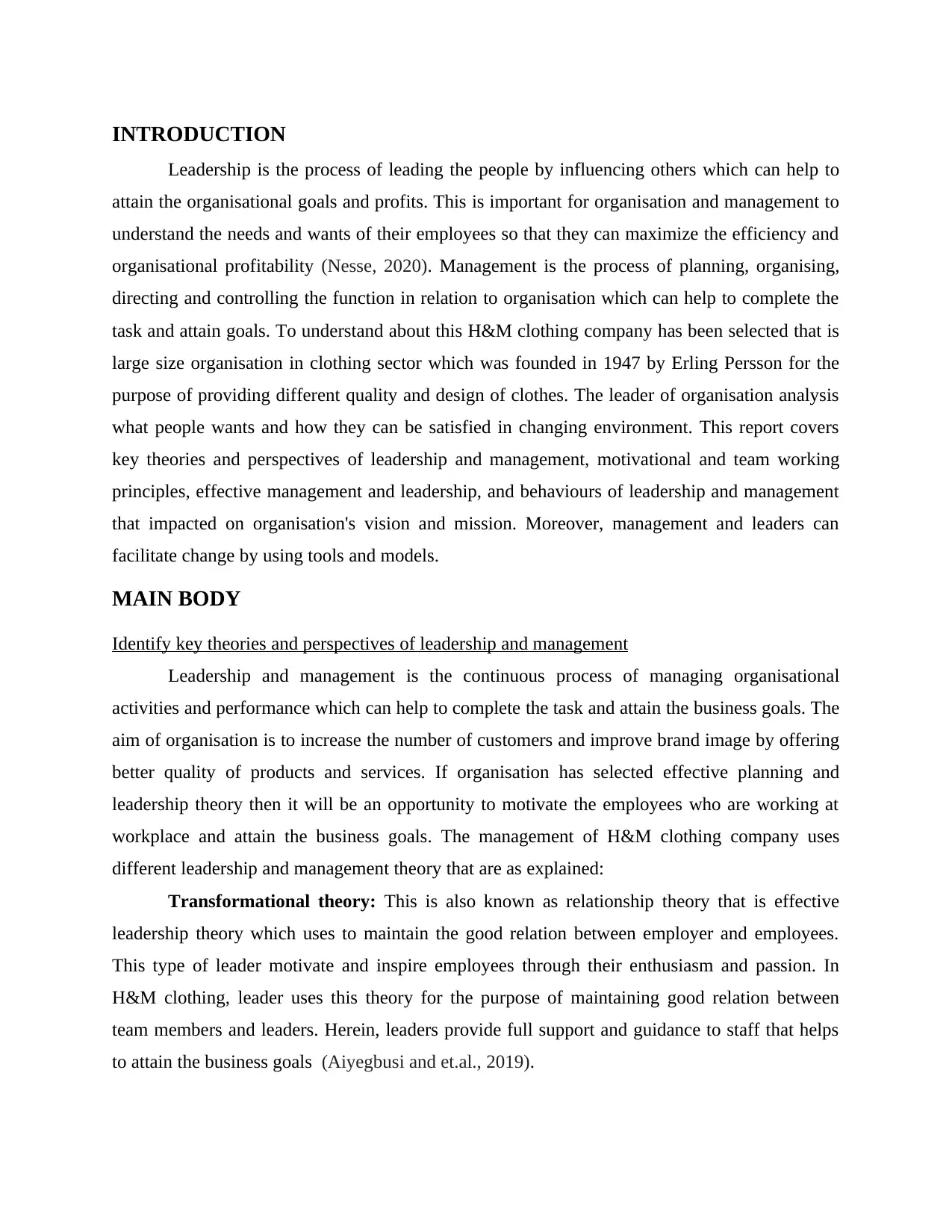
INTRODUCTION
Leadership is the process of leading the people by influencing others which can help to
attain the organisational goals and profits. This is important for organisation and management to
understand the needs and wants of their employees so that they can maximize the efficiency and
organisational profitability (Nesse, 2020). Management is the process of planning, organising,
directing and controlling the function in relation to organisation which can help to complete the
task and attain goals. To understand about this H&M clothing company has been selected that is
large size organisation in clothing sector which was founded in 1947 by Erling Persson for the
purpose of providing different quality and design of clothes. The leader of organisation analysis
what people wants and how they can be satisfied in changing environment. This report covers
key theories and perspectives of leadership and management, motivational and team working
principles, effective management and leadership, and behaviours of leadership and management
that impacted on organisation's vision and mission. Moreover, management and leaders can
facilitate change by using tools and models.
MAIN BODY
Identify key theories and perspectives of leadership and management
Leadership and management is the continuous process of managing organisational
activities and performance which can help to complete the task and attain the business goals. The
aim of organisation is to increase the number of customers and improve brand image by offering
better quality of products and services. If organisation has selected effective planning and
leadership theory then it will be an opportunity to motivate the employees who are working at
workplace and attain the business goals. The management of H&M clothing company uses
different leadership and management theory that are as explained:
Transformational theory: This is also known as relationship theory that is effective
leadership theory which uses to maintain the good relation between employer and employees.
This type of leader motivate and inspire employees through their enthusiasm and passion. In
H&M clothing, leader uses this theory for the purpose of maintaining good relation between
team members and leaders. Herein, leaders provide full support and guidance to staff that helps
to attain the business goals (Aiyegbusi and et.al., 2019).
Leadership is the process of leading the people by influencing others which can help to
attain the organisational goals and profits. This is important for organisation and management to
understand the needs and wants of their employees so that they can maximize the efficiency and
organisational profitability (Nesse, 2020). Management is the process of planning, organising,
directing and controlling the function in relation to organisation which can help to complete the
task and attain goals. To understand about this H&M clothing company has been selected that is
large size organisation in clothing sector which was founded in 1947 by Erling Persson for the
purpose of providing different quality and design of clothes. The leader of organisation analysis
what people wants and how they can be satisfied in changing environment. This report covers
key theories and perspectives of leadership and management, motivational and team working
principles, effective management and leadership, and behaviours of leadership and management
that impacted on organisation's vision and mission. Moreover, management and leaders can
facilitate change by using tools and models.
MAIN BODY
Identify key theories and perspectives of leadership and management
Leadership and management is the continuous process of managing organisational
activities and performance which can help to complete the task and attain the business goals. The
aim of organisation is to increase the number of customers and improve brand image by offering
better quality of products and services. If organisation has selected effective planning and
leadership theory then it will be an opportunity to motivate the employees who are working at
workplace and attain the business goals. The management of H&M clothing company uses
different leadership and management theory that are as explained:
Transformational theory: This is also known as relationship theory that is effective
leadership theory which uses to maintain the good relation between employer and employees.
This type of leader motivate and inspire employees through their enthusiasm and passion. In
H&M clothing, leader uses this theory for the purpose of maintaining good relation between
team members and leaders. Herein, leaders provide full support and guidance to staff that helps
to attain the business goals (Aiyegbusi and et.al., 2019).
⊘ This is a preview!⊘
Do you want full access?
Subscribe today to unlock all pages.

Trusted by 1+ million students worldwide
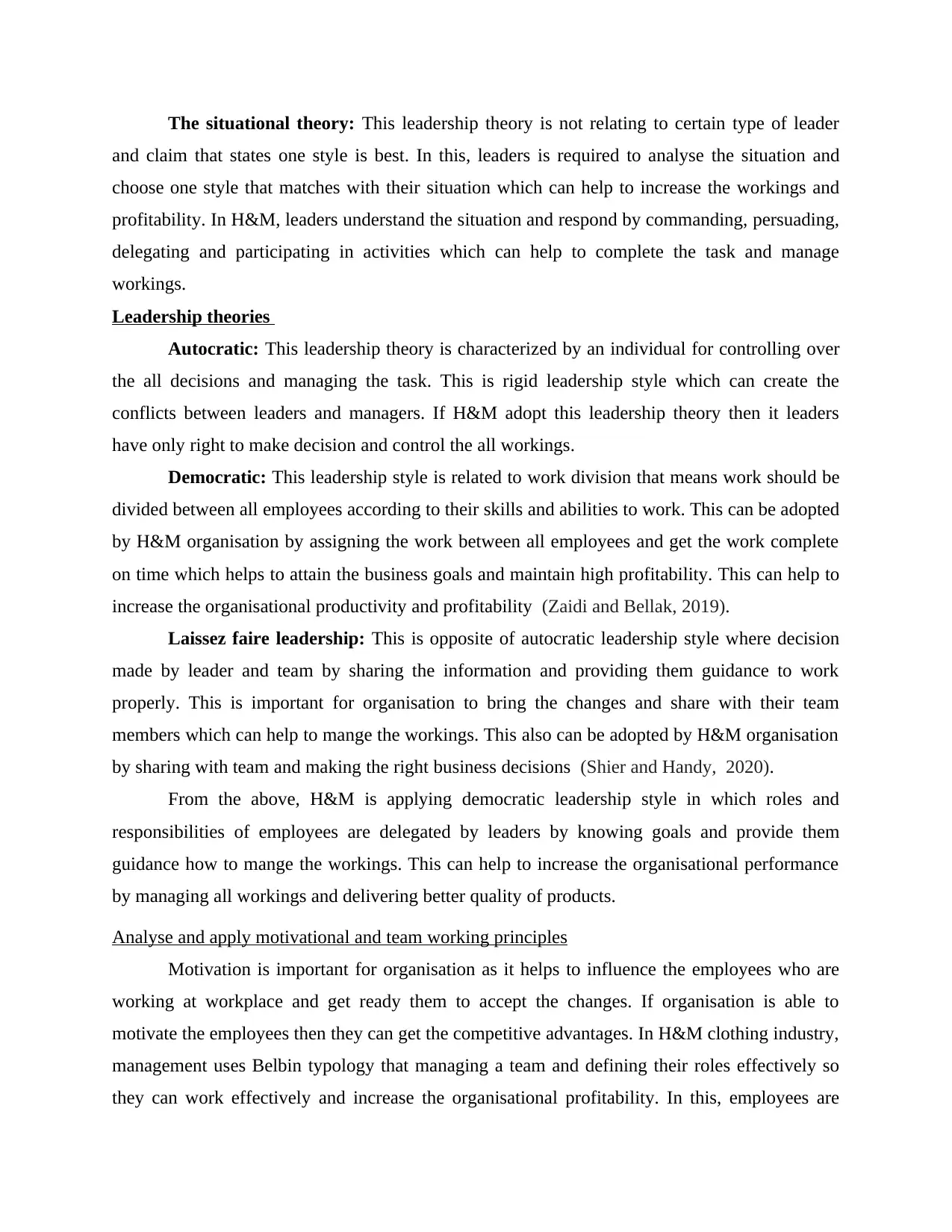
The situational theory: This leadership theory is not relating to certain type of leader
and claim that states one style is best. In this, leaders is required to analyse the situation and
choose one style that matches with their situation which can help to increase the workings and
profitability. In H&M, leaders understand the situation and respond by commanding, persuading,
delegating and participating in activities which can help to complete the task and manage
workings.
Leadership theories
Autocratic: This leadership theory is characterized by an individual for controlling over
the all decisions and managing the task. This is rigid leadership style which can create the
conflicts between leaders and managers. If H&M adopt this leadership theory then it leaders
have only right to make decision and control the all workings.
Democratic: This leadership style is related to work division that means work should be
divided between all employees according to their skills and abilities to work. This can be adopted
by H&M organisation by assigning the work between all employees and get the work complete
on time which helps to attain the business goals and maintain high profitability. This can help to
increase the organisational productivity and profitability (Zaidi and Bellak, 2019).
Laissez faire leadership: This is opposite of autocratic leadership style where decision
made by leader and team by sharing the information and providing them guidance to work
properly. This is important for organisation to bring the changes and share with their team
members which can help to mange the workings. This also can be adopted by H&M organisation
by sharing with team and making the right business decisions (Shier and Handy, 2020).
From the above, H&M is applying democratic leadership style in which roles and
responsibilities of employees are delegated by leaders by knowing goals and provide them
guidance how to mange the workings. This can help to increase the organisational performance
by managing all workings and delivering better quality of products.
Analyse and apply motivational and team working principles
Motivation is important for organisation as it helps to influence the employees who are
working at workplace and get ready them to accept the changes. If organisation is able to
motivate the employees then they can get the competitive advantages. In H&M clothing industry,
management uses Belbin typology that managing a team and defining their roles effectively so
they can work effectively and increase the organisational profitability. In this, employees are
and claim that states one style is best. In this, leaders is required to analyse the situation and
choose one style that matches with their situation which can help to increase the workings and
profitability. In H&M, leaders understand the situation and respond by commanding, persuading,
delegating and participating in activities which can help to complete the task and manage
workings.
Leadership theories
Autocratic: This leadership theory is characterized by an individual for controlling over
the all decisions and managing the task. This is rigid leadership style which can create the
conflicts between leaders and managers. If H&M adopt this leadership theory then it leaders
have only right to make decision and control the all workings.
Democratic: This leadership style is related to work division that means work should be
divided between all employees according to their skills and abilities to work. This can be adopted
by H&M organisation by assigning the work between all employees and get the work complete
on time which helps to attain the business goals and maintain high profitability. This can help to
increase the organisational productivity and profitability (Zaidi and Bellak, 2019).
Laissez faire leadership: This is opposite of autocratic leadership style where decision
made by leader and team by sharing the information and providing them guidance to work
properly. This is important for organisation to bring the changes and share with their team
members which can help to mange the workings. This also can be adopted by H&M organisation
by sharing with team and making the right business decisions (Shier and Handy, 2020).
From the above, H&M is applying democratic leadership style in which roles and
responsibilities of employees are delegated by leaders by knowing goals and provide them
guidance how to mange the workings. This can help to increase the organisational performance
by managing all workings and delivering better quality of products.
Analyse and apply motivational and team working principles
Motivation is important for organisation as it helps to influence the employees who are
working at workplace and get ready them to accept the changes. If organisation is able to
motivate the employees then they can get the competitive advantages. In H&M clothing industry,
management uses Belbin typology that managing a team and defining their roles effectively so
they can work effectively and increase the organisational profitability. In this, employees are
Paraphrase This Document
Need a fresh take? Get an instant paraphrase of this document with our AI Paraphraser
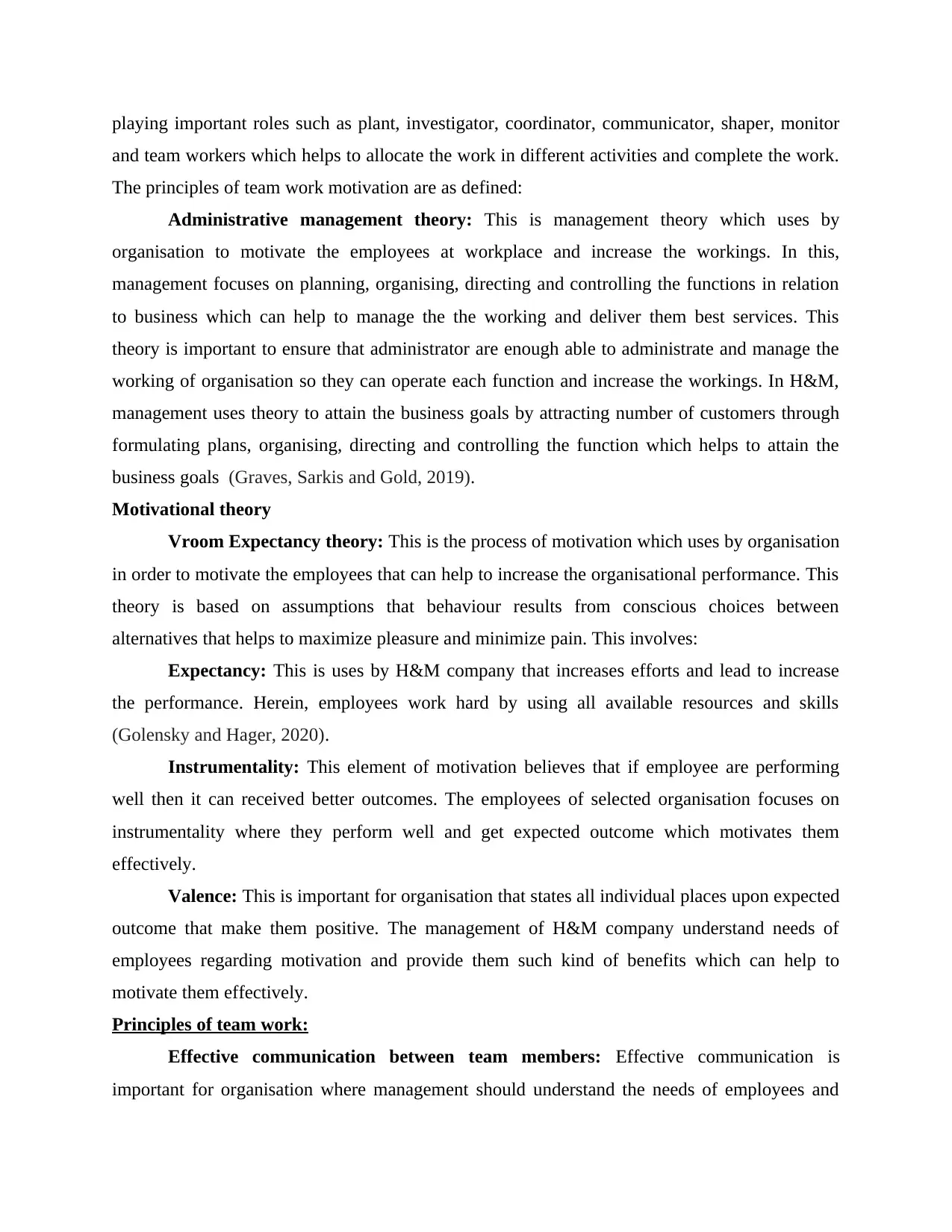
playing important roles such as plant, investigator, coordinator, communicator, shaper, monitor
and team workers which helps to allocate the work in different activities and complete the work.
The principles of team work motivation are as defined:
Administrative management theory: This is management theory which uses by
organisation to motivate the employees at workplace and increase the workings. In this,
management focuses on planning, organising, directing and controlling the functions in relation
to business which can help to manage the the working and deliver them best services. This
theory is important to ensure that administrator are enough able to administrate and manage the
working of organisation so they can operate each function and increase the workings. In H&M,
management uses theory to attain the business goals by attracting number of customers through
formulating plans, organising, directing and controlling the function which helps to attain the
business goals (Graves, Sarkis and Gold, 2019).
Motivational theory
Vroom Expectancy theory: This is the process of motivation which uses by organisation
in order to motivate the employees that can help to increase the organisational performance. This
theory is based on assumptions that behaviour results from conscious choices between
alternatives that helps to maximize pleasure and minimize pain. This involves:
Expectancy: This is uses by H&M company that increases efforts and lead to increase
the performance. Herein, employees work hard by using all available resources and skills
(Golensky and Hager, 2020).
Instrumentality: This element of motivation believes that if employee are performing
well then it can received better outcomes. The employees of selected organisation focuses on
instrumentality where they perform well and get expected outcome which motivates them
effectively.
Valence: This is important for organisation that states all individual places upon expected
outcome that make them positive. The management of H&M company understand needs of
employees regarding motivation and provide them such kind of benefits which can help to
motivate them effectively.
Principles of team work:
Effective communication between team members: Effective communication is
important for organisation where management should understand the needs of employees and
and team workers which helps to allocate the work in different activities and complete the work.
The principles of team work motivation are as defined:
Administrative management theory: This is management theory which uses by
organisation to motivate the employees at workplace and increase the workings. In this,
management focuses on planning, organising, directing and controlling the functions in relation
to business which can help to manage the the working and deliver them best services. This
theory is important to ensure that administrator are enough able to administrate and manage the
working of organisation so they can operate each function and increase the workings. In H&M,
management uses theory to attain the business goals by attracting number of customers through
formulating plans, organising, directing and controlling the function which helps to attain the
business goals (Graves, Sarkis and Gold, 2019).
Motivational theory
Vroom Expectancy theory: This is the process of motivation which uses by organisation
in order to motivate the employees that can help to increase the organisational performance. This
theory is based on assumptions that behaviour results from conscious choices between
alternatives that helps to maximize pleasure and minimize pain. This involves:
Expectancy: This is uses by H&M company that increases efforts and lead to increase
the performance. Herein, employees work hard by using all available resources and skills
(Golensky and Hager, 2020).
Instrumentality: This element of motivation believes that if employee are performing
well then it can received better outcomes. The employees of selected organisation focuses on
instrumentality where they perform well and get expected outcome which motivates them
effectively.
Valence: This is important for organisation that states all individual places upon expected
outcome that make them positive. The management of H&M company understand needs of
employees regarding motivation and provide them such kind of benefits which can help to
motivate them effectively.
Principles of team work:
Effective communication between team members: Effective communication is
important for organisation where management should understand the needs of employees and
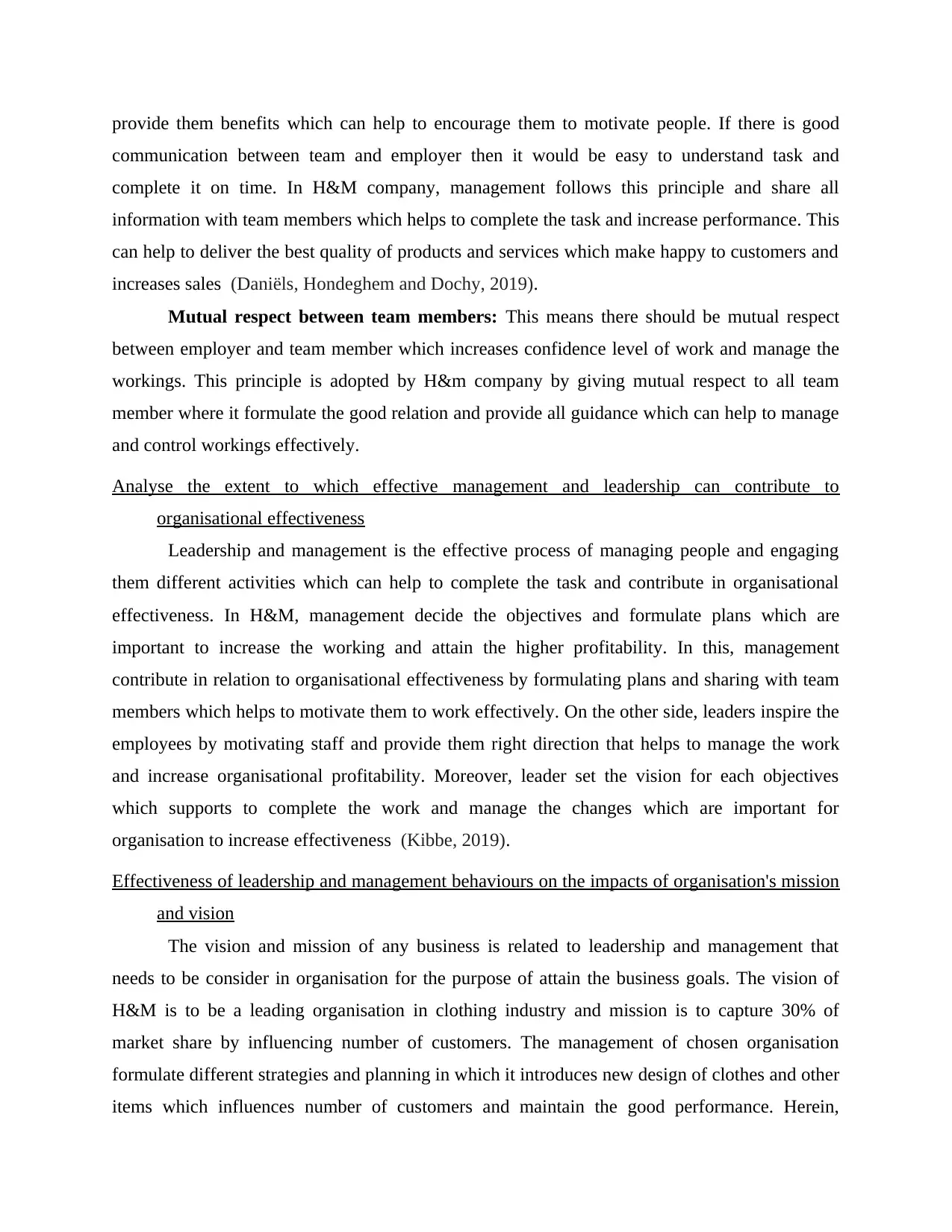
provide them benefits which can help to encourage them to motivate people. If there is good
communication between team and employer then it would be easy to understand task and
complete it on time. In H&M company, management follows this principle and share all
information with team members which helps to complete the task and increase performance. This
can help to deliver the best quality of products and services which make happy to customers and
increases sales (Daniëls, Hondeghem and Dochy, 2019).
Mutual respect between team members: This means there should be mutual respect
between employer and team member which increases confidence level of work and manage the
workings. This principle is adopted by H&m company by giving mutual respect to all team
member where it formulate the good relation and provide all guidance which can help to manage
and control workings effectively.
Analyse the extent to which effective management and leadership can contribute to
organisational effectiveness
Leadership and management is the effective process of managing people and engaging
them different activities which can help to complete the task and contribute in organisational
effectiveness. In H&M, management decide the objectives and formulate plans which are
important to increase the working and attain the higher profitability. In this, management
contribute in relation to organisational effectiveness by formulating plans and sharing with team
members which helps to motivate them to work effectively. On the other side, leaders inspire the
employees by motivating staff and provide them right direction that helps to manage the work
and increase organisational profitability. Moreover, leader set the vision for each objectives
which supports to complete the work and manage the changes which are important for
organisation to increase effectiveness (Kibbe, 2019).
Effectiveness of leadership and management behaviours on the impacts of organisation's mission
and vision
The vision and mission of any business is related to leadership and management that
needs to be consider in organisation for the purpose of attain the business goals. The vision of
H&M is to be a leading organisation in clothing industry and mission is to capture 30% of
market share by influencing number of customers. The management of chosen organisation
formulate different strategies and planning in which it introduces new design of clothes and other
items which influences number of customers and maintain the good performance. Herein,
communication between team and employer then it would be easy to understand task and
complete it on time. In H&M company, management follows this principle and share all
information with team members which helps to complete the task and increase performance. This
can help to deliver the best quality of products and services which make happy to customers and
increases sales (Daniëls, Hondeghem and Dochy, 2019).
Mutual respect between team members: This means there should be mutual respect
between employer and team member which increases confidence level of work and manage the
workings. This principle is adopted by H&m company by giving mutual respect to all team
member where it formulate the good relation and provide all guidance which can help to manage
and control workings effectively.
Analyse the extent to which effective management and leadership can contribute to
organisational effectiveness
Leadership and management is the effective process of managing people and engaging
them different activities which can help to complete the task and contribute in organisational
effectiveness. In H&M, management decide the objectives and formulate plans which are
important to increase the working and attain the higher profitability. In this, management
contribute in relation to organisational effectiveness by formulating plans and sharing with team
members which helps to motivate them to work effectively. On the other side, leaders inspire the
employees by motivating staff and provide them right direction that helps to manage the work
and increase organisational profitability. Moreover, leader set the vision for each objectives
which supports to complete the work and manage the changes which are important for
organisation to increase effectiveness (Kibbe, 2019).
Effectiveness of leadership and management behaviours on the impacts of organisation's mission
and vision
The vision and mission of any business is related to leadership and management that
needs to be consider in organisation for the purpose of attain the business goals. The vision of
H&M is to be a leading organisation in clothing industry and mission is to capture 30% of
market share by influencing number of customers. The management of chosen organisation
formulate different strategies and planning in which it introduces new design of clothes and other
items which influences number of customers and maintain the good performance. Herein,
⊘ This is a preview!⊘
Do you want full access?
Subscribe today to unlock all pages.

Trusted by 1+ million students worldwide
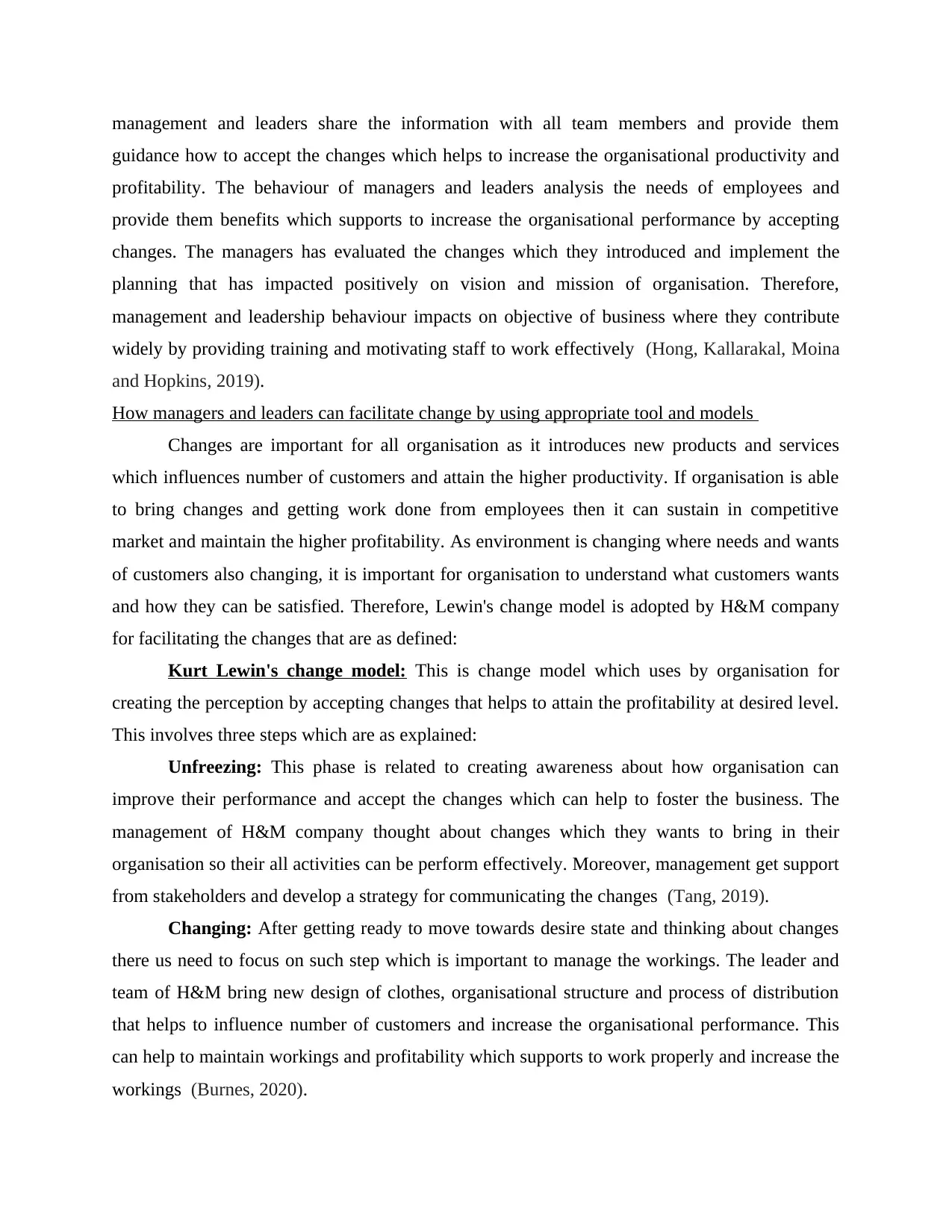
management and leaders share the information with all team members and provide them
guidance how to accept the changes which helps to increase the organisational productivity and
profitability. The behaviour of managers and leaders analysis the needs of employees and
provide them benefits which supports to increase the organisational performance by accepting
changes. The managers has evaluated the changes which they introduced and implement the
planning that has impacted positively on vision and mission of organisation. Therefore,
management and leadership behaviour impacts on objective of business where they contribute
widely by providing training and motivating staff to work effectively (Hong, Kallarakal, Moina
and Hopkins, 2019).
How managers and leaders can facilitate change by using appropriate tool and models
Changes are important for all organisation as it introduces new products and services
which influences number of customers and attain the higher productivity. If organisation is able
to bring changes and getting work done from employees then it can sustain in competitive
market and maintain the higher profitability. As environment is changing where needs and wants
of customers also changing, it is important for organisation to understand what customers wants
and how they can be satisfied. Therefore, Lewin's change model is adopted by H&M company
for facilitating the changes that are as defined:
Kurt Lewin's change model: This is change model which uses by organisation for
creating the perception by accepting changes that helps to attain the profitability at desired level.
This involves three steps which are as explained:
Unfreezing: This phase is related to creating awareness about how organisation can
improve their performance and accept the changes which can help to foster the business. The
management of H&M company thought about changes which they wants to bring in their
organisation so their all activities can be perform effectively. Moreover, management get support
from stakeholders and develop a strategy for communicating the changes (Tang, 2019).
Changing: After getting ready to move towards desire state and thinking about changes
there us need to focus on such step which is important to manage the workings. The leader and
team of H&M bring new design of clothes, organisational structure and process of distribution
that helps to influence number of customers and increase the organisational performance. This
can help to maintain workings and profitability which supports to work properly and increase the
workings (Burnes, 2020).
guidance how to accept the changes which helps to increase the organisational productivity and
profitability. The behaviour of managers and leaders analysis the needs of employees and
provide them benefits which supports to increase the organisational performance by accepting
changes. The managers has evaluated the changes which they introduced and implement the
planning that has impacted positively on vision and mission of organisation. Therefore,
management and leadership behaviour impacts on objective of business where they contribute
widely by providing training and motivating staff to work effectively (Hong, Kallarakal, Moina
and Hopkins, 2019).
How managers and leaders can facilitate change by using appropriate tool and models
Changes are important for all organisation as it introduces new products and services
which influences number of customers and attain the higher productivity. If organisation is able
to bring changes and getting work done from employees then it can sustain in competitive
market and maintain the higher profitability. As environment is changing where needs and wants
of customers also changing, it is important for organisation to understand what customers wants
and how they can be satisfied. Therefore, Lewin's change model is adopted by H&M company
for facilitating the changes that are as defined:
Kurt Lewin's change model: This is change model which uses by organisation for
creating the perception by accepting changes that helps to attain the profitability at desired level.
This involves three steps which are as explained:
Unfreezing: This phase is related to creating awareness about how organisation can
improve their performance and accept the changes which can help to foster the business. The
management of H&M company thought about changes which they wants to bring in their
organisation so their all activities can be perform effectively. Moreover, management get support
from stakeholders and develop a strategy for communicating the changes (Tang, 2019).
Changing: After getting ready to move towards desire state and thinking about changes
there us need to focus on such step which is important to manage the workings. The leader and
team of H&M bring new design of clothes, organisational structure and process of distribution
that helps to influence number of customers and increase the organisational performance. This
can help to maintain workings and profitability which supports to work properly and increase the
workings (Burnes, 2020).
Paraphrase This Document
Need a fresh take? Get an instant paraphrase of this document with our AI Paraphraser
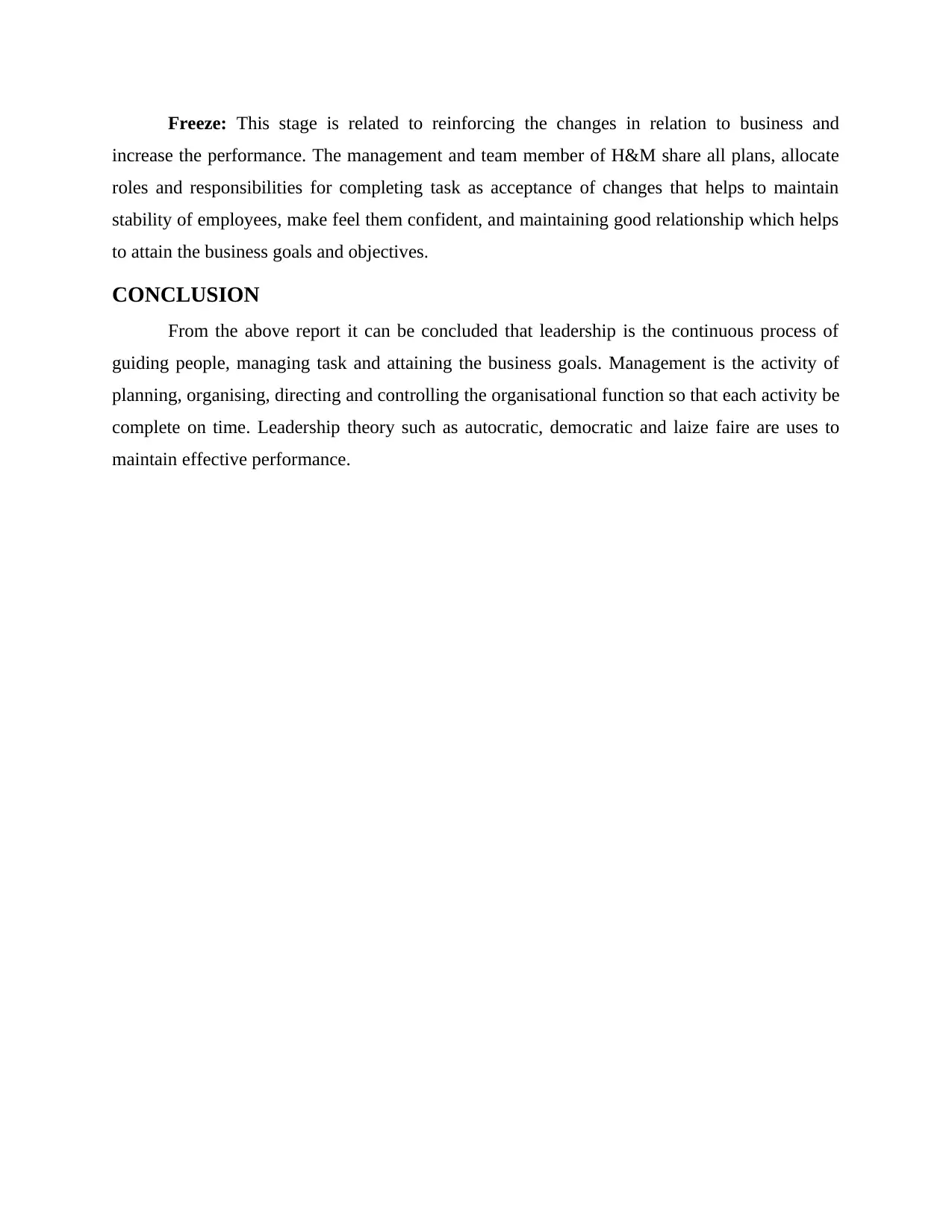
Freeze: This stage is related to reinforcing the changes in relation to business and
increase the performance. The management and team member of H&M share all plans, allocate
roles and responsibilities for completing task as acceptance of changes that helps to maintain
stability of employees, make feel them confident, and maintaining good relationship which helps
to attain the business goals and objectives.
CONCLUSION
From the above report it can be concluded that leadership is the continuous process of
guiding people, managing task and attaining the business goals. Management is the activity of
planning, organising, directing and controlling the organisational function so that each activity be
complete on time. Leadership theory such as autocratic, democratic and laize faire are uses to
maintain effective performance.
increase the performance. The management and team member of H&M share all plans, allocate
roles and responsibilities for completing task as acceptance of changes that helps to maintain
stability of employees, make feel them confident, and maintaining good relationship which helps
to attain the business goals and objectives.
CONCLUSION
From the above report it can be concluded that leadership is the continuous process of
guiding people, managing task and attaining the business goals. Management is the activity of
planning, organising, directing and controlling the organisational function so that each activity be
complete on time. Leadership theory such as autocratic, democratic and laize faire are uses to
maintain effective performance.
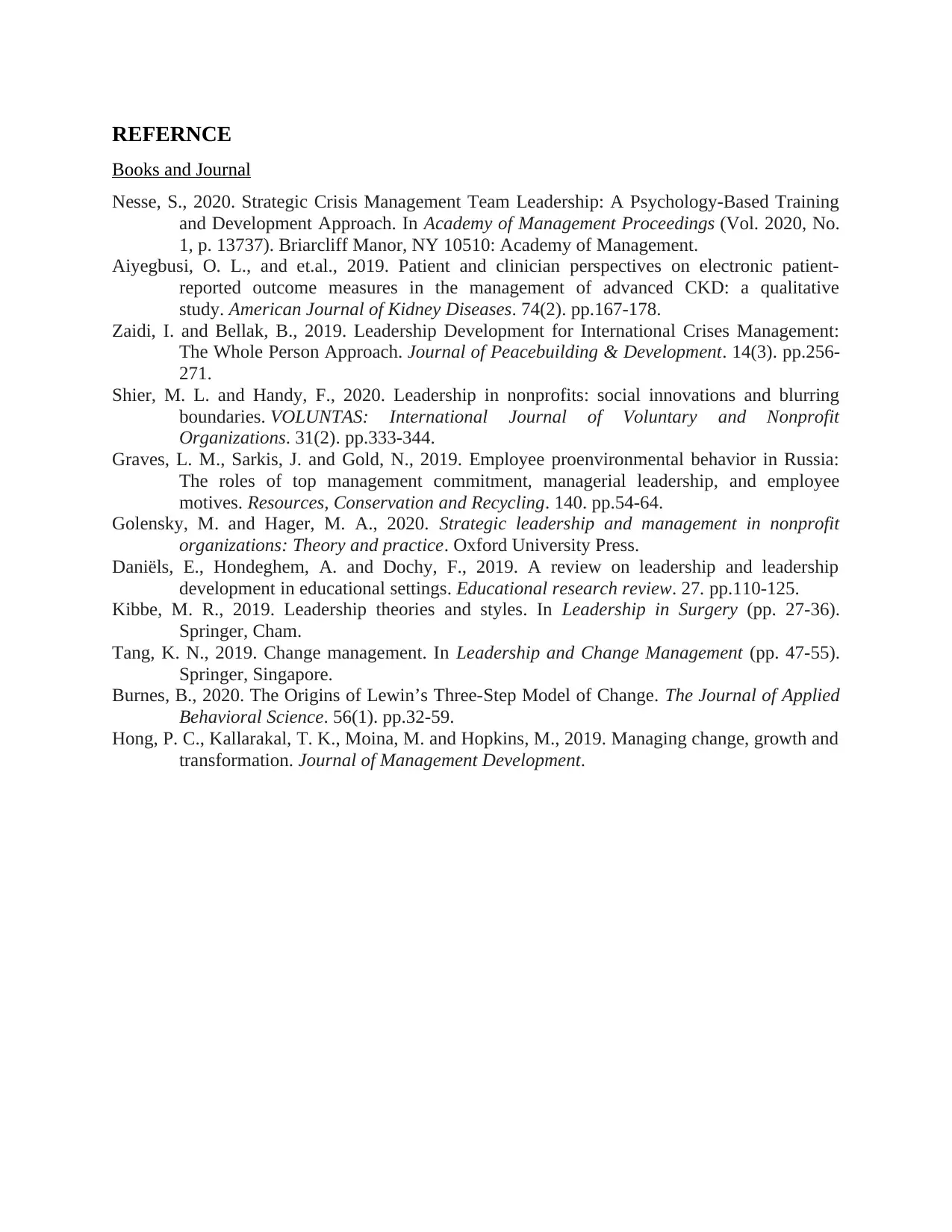
REFERNCE
Books and Journal
Nesse, S., 2020. Strategic Crisis Management Team Leadership: A Psychology-Based Training
and Development Approach. In Academy of Management Proceedings (Vol. 2020, No.
1, p. 13737). Briarcliff Manor, NY 10510: Academy of Management.
Aiyegbusi, O. L., and et.al., 2019. Patient and clinician perspectives on electronic patient-
reported outcome measures in the management of advanced CKD: a qualitative
study. American Journal of Kidney Diseases. 74(2). pp.167-178.
Zaidi, I. and Bellak, B., 2019. Leadership Development for International Crises Management:
The Whole Person Approach. Journal of Peacebuilding & Development. 14(3). pp.256-
271.
Shier, M. L. and Handy, F., 2020. Leadership in nonprofits: social innovations and blurring
boundaries. VOLUNTAS: International Journal of Voluntary and Nonprofit
Organizations. 31(2). pp.333-344.
Graves, L. M., Sarkis, J. and Gold, N., 2019. Employee proenvironmental behavior in Russia:
The roles of top management commitment, managerial leadership, and employee
motives. Resources, Conservation and Recycling. 140. pp.54-64.
Golensky, M. and Hager, M. A., 2020. Strategic leadership and management in nonprofit
organizations: Theory and practice. Oxford University Press.
Daniëls, E., Hondeghem, A. and Dochy, F., 2019. A review on leadership and leadership
development in educational settings. Educational research review. 27. pp.110-125.
Kibbe, M. R., 2019. Leadership theories and styles. In Leadership in Surgery (pp. 27-36).
Springer, Cham.
Tang, K. N., 2019. Change management. In Leadership and Change Management (pp. 47-55).
Springer, Singapore.
Burnes, B., 2020. The Origins of Lewin’s Three-Step Model of Change. The Journal of Applied
Behavioral Science. 56(1). pp.32-59.
Hong, P. C., Kallarakal, T. K., Moina, M. and Hopkins, M., 2019. Managing change, growth and
transformation. Journal of Management Development.
Books and Journal
Nesse, S., 2020. Strategic Crisis Management Team Leadership: A Psychology-Based Training
and Development Approach. In Academy of Management Proceedings (Vol. 2020, No.
1, p. 13737). Briarcliff Manor, NY 10510: Academy of Management.
Aiyegbusi, O. L., and et.al., 2019. Patient and clinician perspectives on electronic patient-
reported outcome measures in the management of advanced CKD: a qualitative
study. American Journal of Kidney Diseases. 74(2). pp.167-178.
Zaidi, I. and Bellak, B., 2019. Leadership Development for International Crises Management:
The Whole Person Approach. Journal of Peacebuilding & Development. 14(3). pp.256-
271.
Shier, M. L. and Handy, F., 2020. Leadership in nonprofits: social innovations and blurring
boundaries. VOLUNTAS: International Journal of Voluntary and Nonprofit
Organizations. 31(2). pp.333-344.
Graves, L. M., Sarkis, J. and Gold, N., 2019. Employee proenvironmental behavior in Russia:
The roles of top management commitment, managerial leadership, and employee
motives. Resources, Conservation and Recycling. 140. pp.54-64.
Golensky, M. and Hager, M. A., 2020. Strategic leadership and management in nonprofit
organizations: Theory and practice. Oxford University Press.
Daniëls, E., Hondeghem, A. and Dochy, F., 2019. A review on leadership and leadership
development in educational settings. Educational research review. 27. pp.110-125.
Kibbe, M. R., 2019. Leadership theories and styles. In Leadership in Surgery (pp. 27-36).
Springer, Cham.
Tang, K. N., 2019. Change management. In Leadership and Change Management (pp. 47-55).
Springer, Singapore.
Burnes, B., 2020. The Origins of Lewin’s Three-Step Model of Change. The Journal of Applied
Behavioral Science. 56(1). pp.32-59.
Hong, P. C., Kallarakal, T. K., Moina, M. and Hopkins, M., 2019. Managing change, growth and
transformation. Journal of Management Development.
⊘ This is a preview!⊘
Do you want full access?
Subscribe today to unlock all pages.

Trusted by 1+ million students worldwide
1 out of 9
Related Documents
Your All-in-One AI-Powered Toolkit for Academic Success.
+13062052269
info@desklib.com
Available 24*7 on WhatsApp / Email
![[object Object]](/_next/static/media/star-bottom.7253800d.svg)
Unlock your academic potential
Copyright © 2020–2025 A2Z Services. All Rights Reserved. Developed and managed by ZUCOL.





